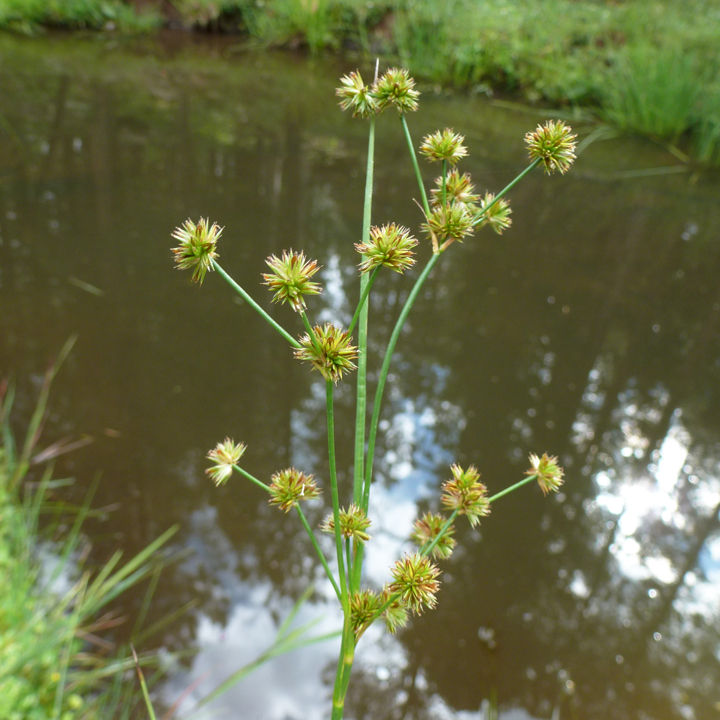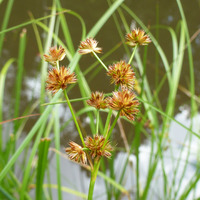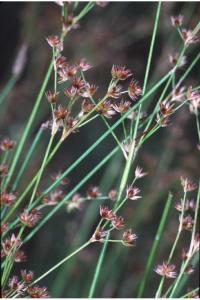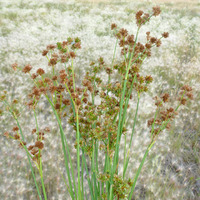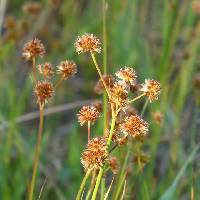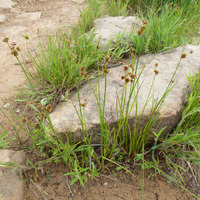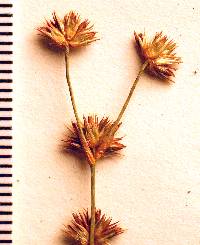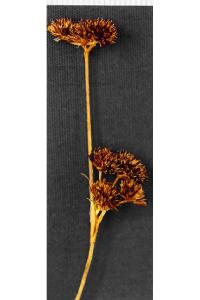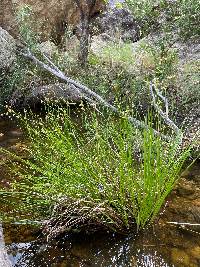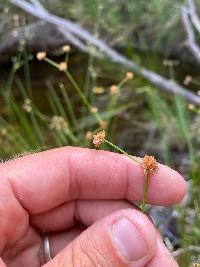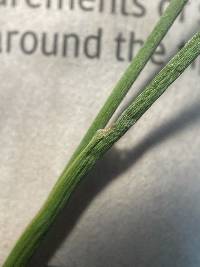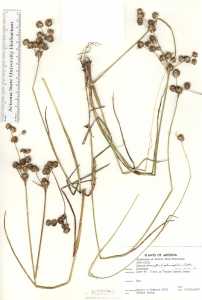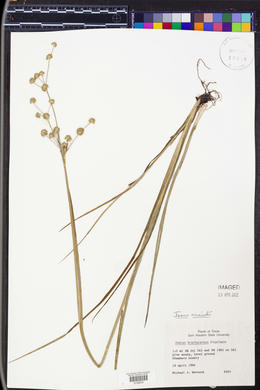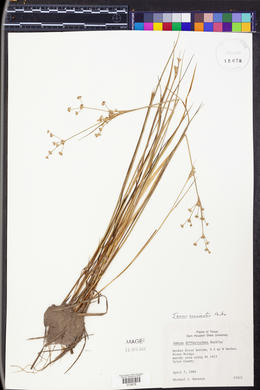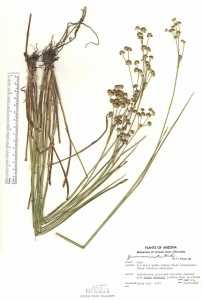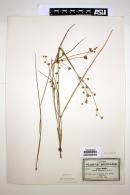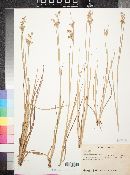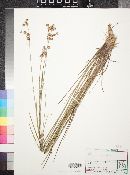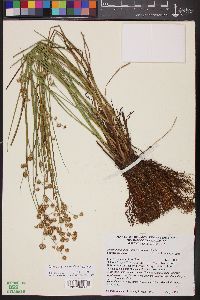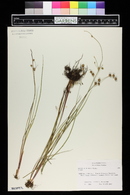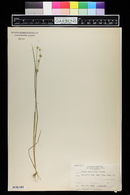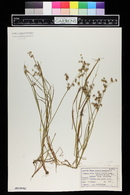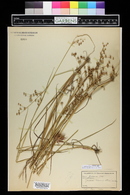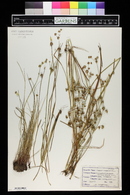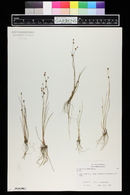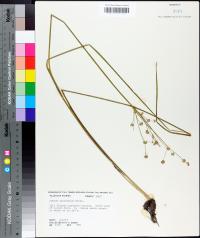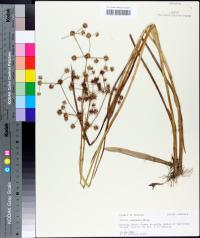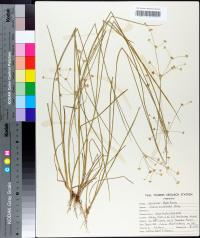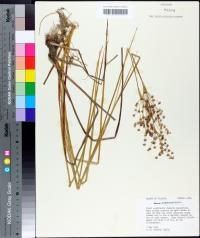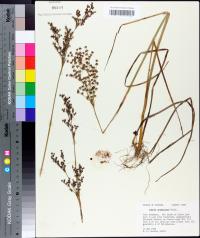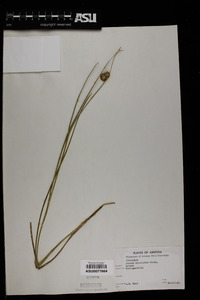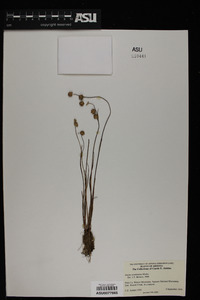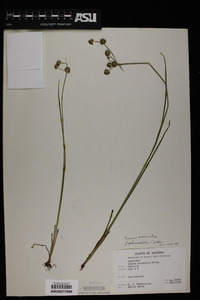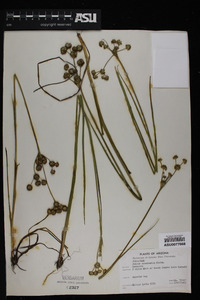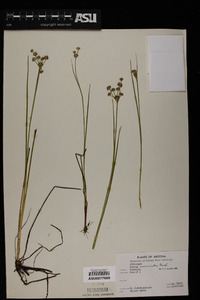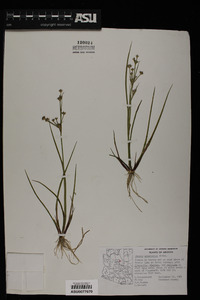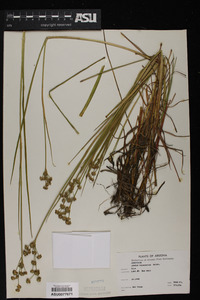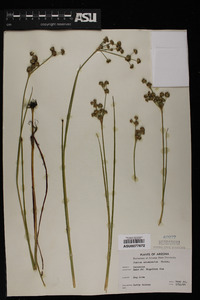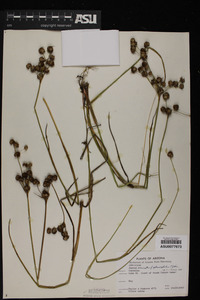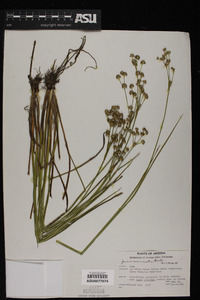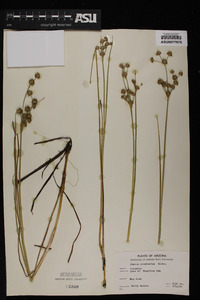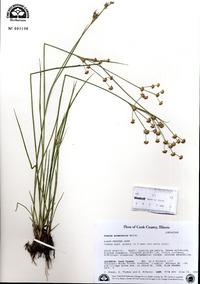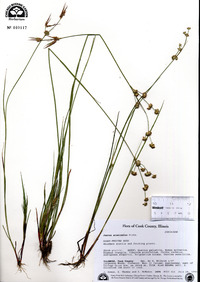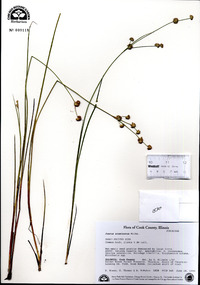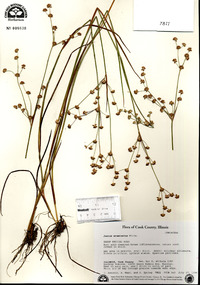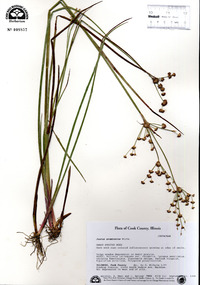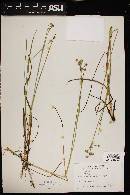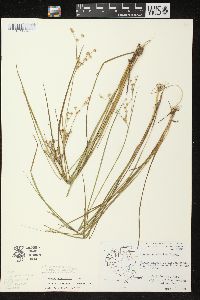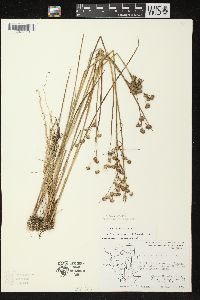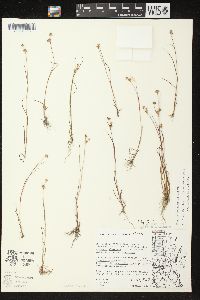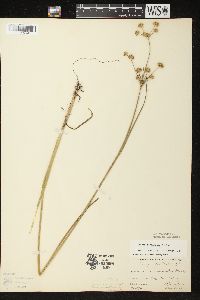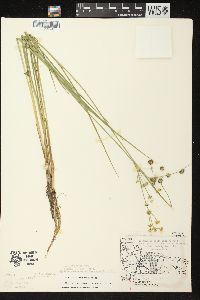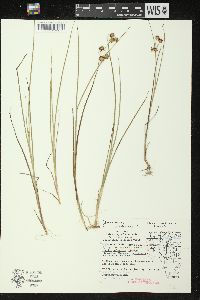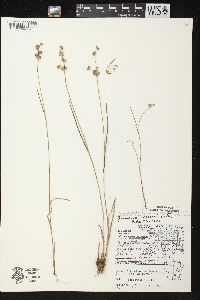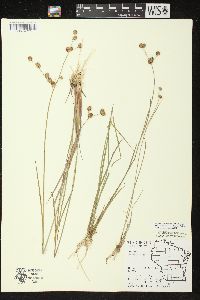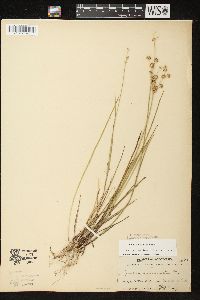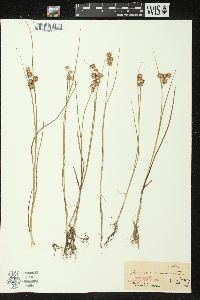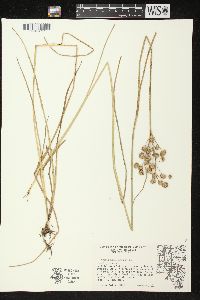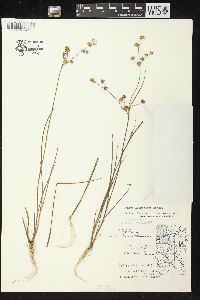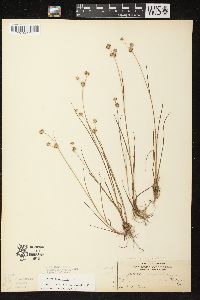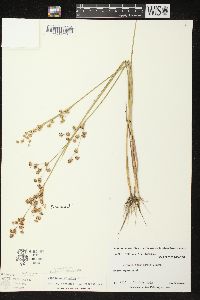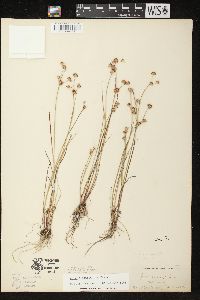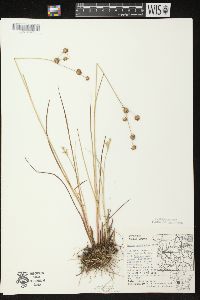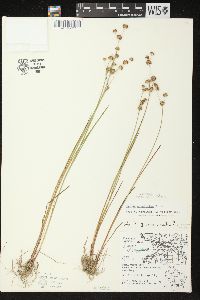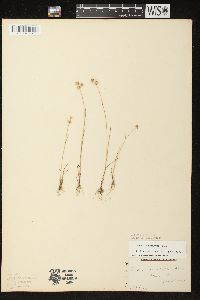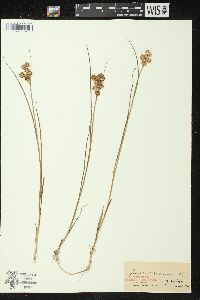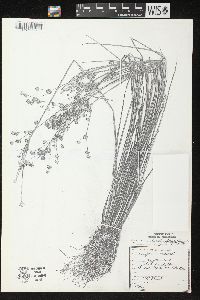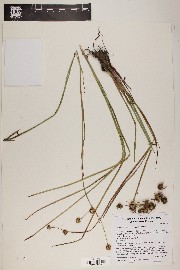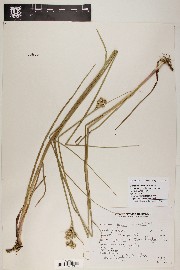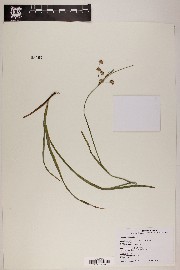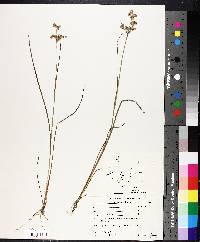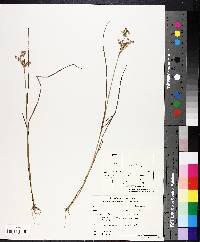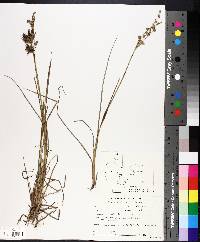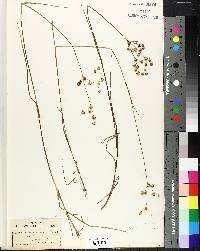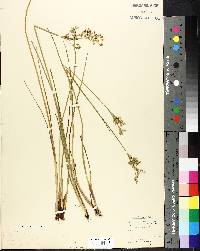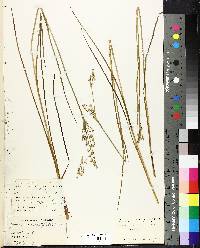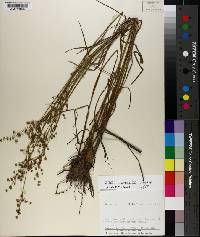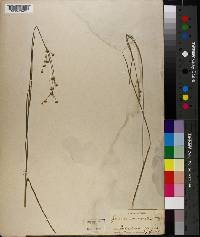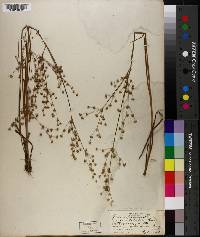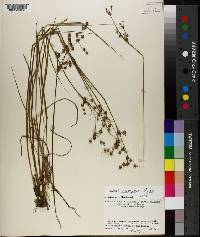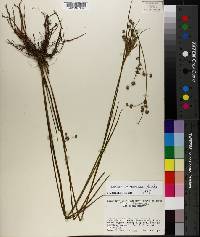Juncus acuminatus
|
|
|
|
Family: Juncaceae
Knotty-Leaf Rush, more...tapertip rush
[Juncus acuminatus f. obtusatus F. J. Herm., moreJuncus acuminatus f. sphaerocephalus F. J. Herm., Juncus acuminatus var. legitimus , Juncus fraternus Kunth, Juncus paradoxus , Juncus pondii] |
Herbs, perennial, cespitose, not rhizomatous, 1.4--10 dm. Culms erect, terete, 1--3 mm diam., smooth. Cataphylls 1--2, gray, apex acute. Leaves: basal 1--2, cauline 1--2; auricles 1--1.5 mm, apex rounded, scarious; blade green, straw-colored, or pink, nearly terete, 1--40 cm. Inflorescences terminal panicles of 5--50 heads, 5--15 cm, branches ascending; primary bract erect; heads (2--)5--20(--50)-flowered, hemispheric (to spheric), 3--10 mm diam. Flowers: tepals light brown to greenish, lanceolate, 2.6--3.5(--3.9) mm, apex acuminate; stamens 3 (or 6), anthers 1/3 filament length. Capsules equaling perianth or slightly exserted, straw-colored, 1-locular, ellipsoid to narrowly ovoid, 2.8--3.5(--4) mm, apex acute, valves separating at dehiscence, fertile throughout or only proximal to middle. Seeds ellipsoid to oblong, 0.3--0.4 mm, not tailed; body clear yellow-brown. 2n = 40. Fruiting early summer--fall. Shores, swamps, ditches, springs, wet meadows, and rock outcrops; 0--2200 m; B.C., N.S., Ont., Que.; Ala., Ariz., Ark., Calif., Colo., Conn., Del., D.C., Fla., Ga., Idaho, Ill., Ind., Iowa, Kans., Ky., La., Maine, Md., Mass., Mich., Minn., Miss., Mo., Mont., Nebr., N.H., N.J., N.Mex., N.Y., N.C., Ohio., Okla., Oreg., Pa., R.I., S.C., Tenn., Tex., Vt., Va., Wash., W.Va., Wis.; Mexico; Central America (Honduras). Perennial grasslike forb 14 cm - 1 m tall Leaves: one or two basal and one or two alternate on stem, green to straw-colored or pinkish, 1 - 40 cm long, linear, grasslike, nearly round in cross section, and with distinct crosswise partitions inside (septate). The leaves also have a thin and papery, basal, 1 - 1.5 mm long, round-tipped, ear-like appendage (auricle) at the top of the leaf sheath. Inflorescence: a terminal, 5 - 15 cm long, narrowly egg-shaped to pyramidal, ascending-branched structure with branches ending in five to fifty, hemispheric to spheric, 0.3 - 1 cm diameter flower clusters. Each flower cluster is a compact head of three to fifty, tiny, radially symmetric flowers. Stamens: three or six, shorter than tepals, with anthers one-third the length of the filaments. Pistil: with one superior ovary, and three stigmas. Fruit: single-chambered, straw-colored, about same height as or slightly taller than tepals (2.8 - 4 mm), three-angled, ellipsoid to narrowly egg-shaped, usually pointed-tipped capsules, which open down the sides. Stems: tufted, erect, smooth, 1 - 3 mm in diameter, and round in cross section. Seeds: many, clear yellow-brown, 0.3 - 0.4 mm long, ellipsoid to oblong with short-pointed or abruptly narrowed tips, but without distinct narrowed tails at the ends. Tepals: six in two whorls of three, light brown to greenish, all about equal length (2.6 - 3.7 mm), lance-shaped with tapered, slender tips. Similar species: Juncus acuminatus is quite similar to J. scirpoides and J. brachycarpus, but those species have obvious tuberous rhizomes, and very long-tapered and pointed tepals. Sometimes J. canadensis may appear similar, except it has capsules that obviously extend beyond the tepals, and the seeds have tails. It would be difficult to confuse this species with J. nodatus since that species has huge inflorescences with many more heads (30 to 250), shorter tepals (1.7 - 2.5 mm), and shorter capsules (1.9 - 2.5 mm). Flowering: late May to September Habitat and ecology: Common or even frequent in various types of moist ground, especially in the eastern Chicago Region counties. Occurence in the Chicago region: native Author: The Field Museum Balslev 1996, FNA 2000 Common Name: tapertip rush Duration: Perennial Nativity: Native Lifeform: Graminoid General: Cespitose perennial, densely branching but short rhizome, 2-4 mm in diameter, 14-100 cm tall, clustered stems erect, terete, 1-3 mm in diameter, smooth; 1-3 cataphylls per stem, green or reddish tinged, apex acute. Vegetative: Basal leaves 1-2, cauline leaves 1-2, auricles 1-1.5 mm, with rounded apex, distinct scarious margins, blade green, straw-colored, or pink, nearly terete, 1-40 cm. Inflorescence: Terminal panicles of 5-50 heads, 5-15 cm, branches ascending, primary bract erect, heads 5-20 flowered, hemispheric to spheric, 3-10 mm in diameter; flower tepals light brown to greenish, lanceolate, 2.5-3.5 mm, acuminate apex; stamens 3, anthers one-third filament length; capsules equaling perianth or slightly exserted, straw-colored, 1-locular, ellipsoid to narrowly ovoid, 2.5-3.5 mm, apex acute, valves separating at dehiscence, fertile throughout or only proximal to middle. Ecology: Found in wet soils of meadows, shores, swamps, springs, and along rock outcrops from 3,000-6,500 ft (914-1981 m); flowers March-October. Notes: Distinguished by the greenish or straw-colored perianth, short rhizome, 3 stamens, and the ovate-lanceolate capsule. Ethnobotany: Unknown Etymology: Juncus comes from the Latin jungere, to join or bind, acuminatus means having a long tapering point. Synonyms: None Editor: SBuckley, 2010 Stems cespitose, erect, slender, 2-8 dm; lvs terete, septate, 1-3 mm thick; infl rarely congested, usually narrowly ovoid or pyramidal, 5-12 cm, less than half as wide, with (3-)5-20(-50) hemispheric or broadly obpyramidal heads 6-10 mm thick, each with (5-)10-50 eprophyllate fls; tep green or stramineous, lance-subulate, subequal, 2.6-3.9 mm, at least the sep broadly scarious-margined, in the lower half; stamens 3(6), shorter than the tep; fr stramineous or light brown, unilocular, about equaling the tep, trigonously ovoid-prismatic, 2.8-4 mm, acute or rarely obtuse, mucronate; 2n=40. Wet soil, meadows, shores, and low woods; Me. and N.S. to Wis., s. to Fla. and Mex.; B.C. to Oreg. Gleason, Henry A. & Cronquist, Arthur J. 1991. Manual of vascular plants of northeastern United States and adjacent Canada. lxxv + 910 pp. ©The New York Botanical Garden. All rights reserved. Used by permission. From Flora of Indiana (1940) by Charles C. Deam Very common in ditches and wet, usually more or less open, habitats of all types; frequently in shallow water in ponds or swamps. Occasionally the heads are proliferous, especially after the habitat has been flooded. …… Indiana Coefficient of Conservatism: C = 4 Wetland Indicator Status: OBL |
|
|
|

